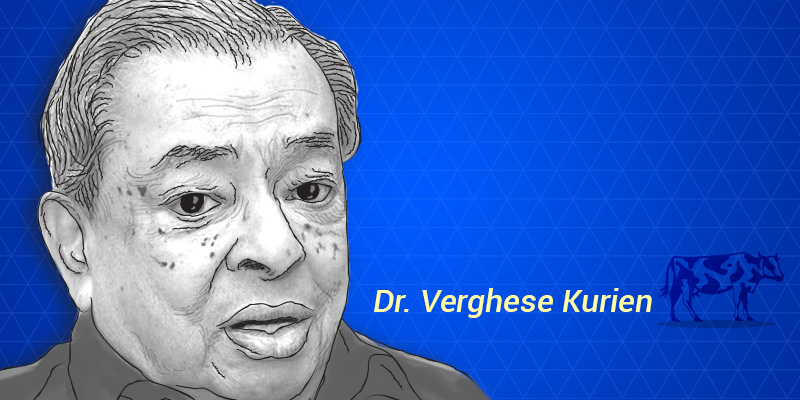The humble revolutionary — IRMA's Prof Bhatt remembers Dr Verghese Kurien on National Milk Day
On the occasion of Dr Verghese Kurien's birth anniversary and National Milk Day, SocialStory spoke to Professor Hitesh Bhatt, Director, Institute of Rural Management Anand, to trace the journey of India’s White Revolution.
How many of us remember the Amul advertisement jingle? Especially for the 90s kids, those quirky tunes are nothing less than a trip down memory lane. The brand’s nostalgia-inducing stream of advertisements, encouraging the little ones to have a glass of milk every day, is likely to stay strong and sharp in memories, for years to come.
But, very few might know the story behind the origins of Amul and the story of Dr Verghese Kurien, the man who started the ‘White Revolution of India’ and who’s credited with efforts to uplift the milk production sector of Gujarat.
On the birth anniversary of the Indian visionary, SocialStory spoke to Professor Hitesh Bhatt, Director of the Institute of Rural Management Anand (IRMA), to understand Dr Kurien’s long journey towards creating this impact.
To date, the institute has seen more than 3000 of its alumni changemakers impacting lives around the world with their work. They have helped create some of the most enduring brands, institutions, and initiatives in the underserved sectors of India, including Amul, ITC e-Choupal, National Rural Livelihoods Mission (NRLM), State Rural Livelihood Missions (SRLM), and Kshetriya Gramin Financial Services (KGFS), among many others.

Professor Hitesh Bhatt - Director Institute of Rural Management Anand (IRMA)
The beginnings and the drivers
In narrating the journey of the White Revolution, Hitesh talks about the days from 1995 when he joined as a professor of the institute and Dr Kurien, who had founded it, was serving as its Chairman.
Recollecting the good old days, the professor says that, soon after he joined the institute, he realised that every new faculty member had to meet Dr Kurien.
Hitesh says,
“I met him with another faculty member who had also joined the institute at the same time. Dr Kurien was very cordial at the meeting. I came from a background in the corporate world, with absolutely no links to rural India. I was brought on board in spite of this. I vividly remember him remarking that I had changed four jobs in the last 16 years while he had remained in the same ecosystem for years. I said that, for me, it was important to bring the values and ethos from my previous organisation to the new one, and he seemed content with the answer. I believe this is how he saw IRMA contributing to the new India as well.”
At that time, Dr Kurien was keen on transforming the dairy sector of the state. There were five key changes which took place under his leadership, Hitesh points out, adding that those were the changes that transformed the outlook of the dairy sector and turned it into India’s largest rural employment provider.
These changes involved developing a robust supply chain for milk procurement, modern technology and production systems, professional marketing, an organisational ecosystem, and, lastly, a strategic vision which played a major role in transforming the lives of India’s dairy farmers.
When asked about the initial phase of the White Revolution, Hitesh quips that he would like to quote Dr Kurien himself from his autobiography, I Too Had a Dream. In his writings, the pioneer had noted that, in July 1970, NDDB officially launched the ‘Billion Litre Idea’ with a goal to take India’s dairy industry from a drop to a flood.
It was to become the biggest dairy development programme in the world. It was envisioned that ‘Operation Flood’ would make India the leading producer of milk and milk products in the world. It was achieved through developing a nationwide milk grid of which Dr Kurien was the architect.
Says Hitesh, quoting Dr Kurien's words,
“These, then, were the simple principles underlying this project, most of them based on good sound marketing. The bedrock of all this, naturally, would be the cooperative system, which would not provide any room for those sucking away margins exploiting both the producer and the consumer. Operation Flood would, therefore, help in establishing a direct link between those who produced the milk and those who consumed it, and the cooperative structure would ensure the transfer of the maximum share of the consumer’s rupee to the producer.”
The development was observed keenly by the then state government, which later pushed for the Anand pattern to be replicated across India and was completely supportive of the White Revolution.
The upliftment and the path ahead
According to Hitesh, the success of Dr Kurien lay in a lot of factors, and the entrepreneurs of today can learn a lesson or two from the way he conducted business.
Giving an insight into Dr Kurien’s pioneering efforts, Hitesh recounts how he took certain steps to uplift the Gujarat Milk Marketing Federation. These steps included the creation of a robust supply chain for milk procurement from villages to the customer’s doorstep. After that, he introduced the first-ever plant in the world for manufacturing buffalo milk powder, thereby introducing modern technology and product systems into a traditional grassroots sector.

The campus
All that the initiative then needed was a brand and a channel to market it; hence, ‘Amul’ was born — a brand that would go on to become one of the most enduring brands in Indian history.
Dr Kurien later created sustainable institutes in villages and at every subsequent level, thereby building an ecosystem that would focus on and address the different aspects of the dairy industry such as policy, strategy, innovation, and teaching.
The Gujarat Cooperative Milk Marketing Federation (GCMMF), National Dairy Development Board (NDDB), National Cooperative Dairy Federation of India (NCDFI), and Vidya Dairy and the Gujarat Cooperative Milk Marketing Federation were all birthed from those efforts.
The ‘Billion Litre Idea’—a strategic vision to scale up the dairy cooperative model pan India—led to the well-known ‘Operation Flood’. The initiative culminated in India surpassing the US to become the world’s largest milk producer by 1998. Most importantly, it played a major role in transforming the lives of women farmers and created livelihood for over 15 million farmers across the country by replicating the dairy cooperative model.
Besides all these efforts, IRMA too played an important role by introducing professional management and governance to an unorganised sector. These efforts have transformed the lives of 100 million dairy farmers in India and created the country’s largest rural industry, points out Hitesh.
It was Dr Kurien’s endeavour to provide professional management to every rural institution in India that led him to establish the IRMA 40 years ago.
Sharing his views on the institute’s contributions, Hitesh recounts,
“I was recently at the West Assam Milk Producers' Co-operative Union Ltd (WAMUL) and I was pleasantly surprised to find local people who still fondly remember the late Shri Sanjay Ghose, an IRMA-n of the first batch, who had a tremendous impact on their lives with his work in Assam in the early 1990s. There are many such stories of illustrious IRMA alumni.”
In the present day, IRMA, led by Hitesh, is focussing on ensuring that the current generation of faculty is prepared for the future while keeping the institute’s values and ethics intact.
“To respect the past while looking ahead at the future — that is what we are looking at. The White Revolution is a milestone event in the modern history of our country, and the lessons from it and from Dr Kurien will endure,” signs off Hitesh.
(Edited by Athirupa Geetha Manichandar)












